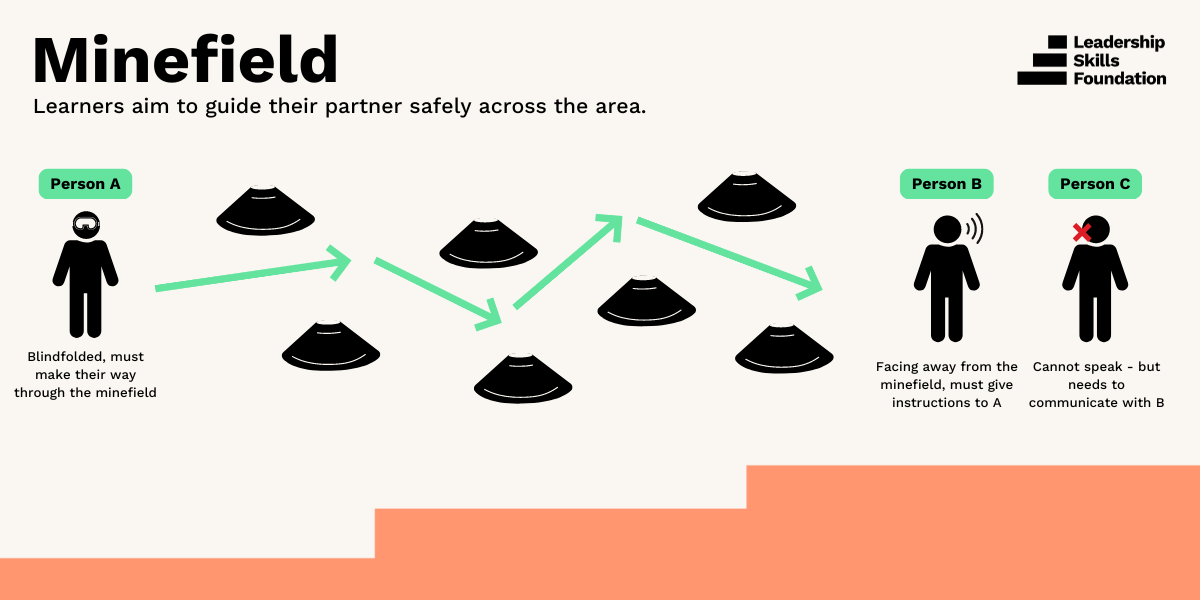
Spring is finally here (maybe – it hasn’t quite made its mind up!), which hopefully means a few brighter days and opportunities to get outdoors and active.
With that in mind, our tutor training team has come up with some ideas for activities to help learners develop their skills, which are ideal to build into sessions this spring.
All these activities are ideal for outdoor spaces and give your learners a chance to develop their teamwork, communication and problem solving skills.
Have a go at some or all of these activities with your learners this spring.
Activity 1: Train tracks
Encouraging learners to use active listening, this activity is all about taking on board instructions and putting them into practice.
The aim is to for learners to complete actions quickly, but they also need to keep them accurate to beat their competition.
Instructions:
- The whole group forms two lines, each person facing their partner, like train tracks.
- The tutor explains the actions linked to each number. For example – 1 = high five, 2 = spin around, 3 = jump, 4 = hip bump etc.
- When a number is shouted, players must carry out the action linked to that number.
- The tutor can make the activity more challenging by shouting a few numbers at once, e.g. 3, 4, 1 means players must jump, hip bump then high five.
- The activity can be made competitive by eliminating the slowest pair each time, to find an eventual winner.
Debrief: Was it easy or difficult to hear the instruction and turn it into action? Were there strategies that helped? As a leader, how can you help participants listen and put into action exactly what you want them to do?
Activity 2: Minefield
This one’s all about working together to communicate instructions designed to help a blindfolded team-mate across an area littered with obstacles. However, it’s not that easy, as the team member giving instructions can’t see the course, so they’ll need guidance from a third team member – who cannot communicate verbally.
It’s a tricky challenge where learners need to think creatively to solve problems and be well organised to think ahead about their journey.
Instructions:
- Working in a group of three – A, B and C – in a working space with a start point, end point and obstacles (such as small cones) dotted between the two.
- A stands at the start point and is blindfolded. B and C stand at the end point.
- C faces A at the start point, B sits in front of C, facing away from A and the start point.
- B must use verbal instructions to guide A safely across the area, avoiding the obstacles.
- However, B can’t see A or the working area (as they are facing away from both) and can only see C.
- Therefore B must rely on the instructions given by C, to guide A across the area. However, C isn’t allowed to speak; they must communicate with B non-verbally. B then gives verbal instructions to A to bring them safely to the end point.
- Before the activity starts, A, B and C decide on a plan – what non-verbal instructions will C give to B, so B knows what to tell A?
- Run the activity once through. Then allow each group of three to reconvene to discuss their plan; does it need adapting at all to be more successful?
- Run the activity again – it can be a race against other teams if appropriate.
Depending on the course and its obstacles, this one might take a couple of goes. What went well and what didn’t go so well? Was the first plan successful? Was the second plan more successful? Why was this? Explore the importance of planning, doing and reviewing as a leader.
Activity 3: Team noughts and crosses
Classic noughts and crosses, but on a much bigger scale and the added element of being a race – what’s not to love?
Working in teams, learners need to race to complete a line for their team; they’ve need to be organised and communicate effectively to work out how to pick their chosen box in the grid before their opponents.
Instructions:
- Set up a relay race with two teams at the top of the working area and one 3×3 square of nine hoops set out at the top of the area (instead of hoops, you could use cones to mark a 3×3 grid)
- One team is noughts and each member holds a red bib, the other is crosses and each team member holds a green bib.
- On ‘go’ the first player from each team runs to the grid and places their bib on a hoop/square of their choice.
- When they return to their team, the next player can go, they also drop their bib in the hoop/square of their choice.
- The winning team is the first to make a line of their colour bibs.
- The game can be extended by making the grid bigger, so teams must create a line of four, five or even six to win.
- Multiple rounds can be played to determine an overall winner.
After the activity, get your learners to think about how it went: what strategies did they use? Did they plan the strategy before or during the activity? If they did it again, would they do anything differently? Was there an obvious leader? What did they do that made them the leader? How might this be relevant when leading others?
Once you’ve tried out some or all these activities with your learners, let us know how it went by sharing your experience and photos on X (formerly Twitter) – and make sure to mention us: @LshipSkillsFdn
